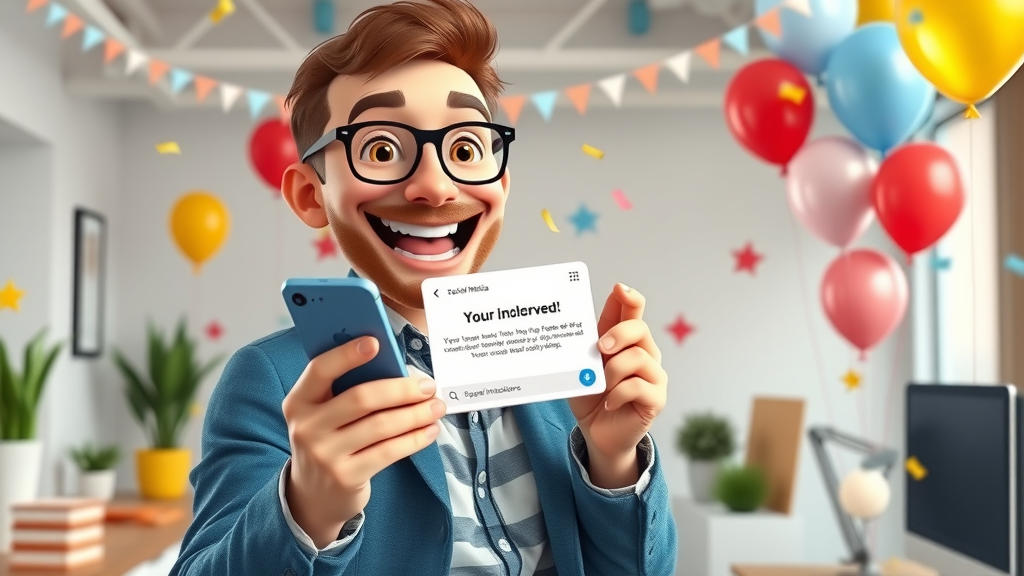Did you know that 73% of small businesses report significant growth after embracing a clear social media marketing strategy? That means a single creative media post can transform your small business marketing and elevate brand awareness overnight. If you're a business owner looking for ways to maximize your social media presence, you've come to the right place. This guide uncovers high-impact small business hacks designed to simplify media marketing, maximize each social channel, and position you ahead of the competition. Read on to discover key strategies, essential tools, and content ideas that ensure every social media effort accelerates your growth!

Unlocking the Power of Social Media Marketing for Small Business Growth
“Did you know that 73% of small businesses report significant growth after implementing a defined social media marketing strategy? A single post can transform your brand awareness overnight.”
For small businesses seeking steady growth, adopting an effective social media marketing small business strategy is essential. Social media platforms like Facebook, Instagram, LinkedIn, and TikTok give small business owners the opportunity to reach thousands of potential customers—often with a minimal budget. When you create content tailored to your target audience and post strategically, you can generate engagement, drive website traffic, and build a loyal community around your brand.
By leveraging the right marketing tools and understanding which types of content work best for each social media platform, small businesses can maximize media efforts for the best ROI. Media marketing is about more than just creating viral trends; it's about building long-term relationships, listening to your audience, and fostering organic growth. In the following sections, we'll dive into actionable hacks, platform selection, content planning, and ways to measure your marketing success.
Maximizing Social Media: What Every Business Owner Needs to Know
- Discover how to harness social media marketing for small business success.
- Learn which media platforms deliver the greatest ROI for your business.
- Craft compelling social media content that resonates with your target audience.
Understanding the ever-changing digital marketing landscape can be challenging for business owners. The first step is to evaluate which social media platforms align with your business goals, resources, and audience. From Instagram’s visual storytelling to LinkedIn’s professional networking, every social channel offers unique advantages for small businesses.
Crafting smart media content is just as crucial as choosing the right media platform. Whether you’re focusing on media post frequency, content quality, or active engagement, your social media success depends on a well-planned, consistent, and data-driven strategy. In this guide, you’ll learn how to select the best platforms, create content that converts, and optimize your social media accounts for growth.
Essential Social Media Marketing Hacks for Small Businesses
Identifying the Right Social Media Platforms for Your Small Business
- Evaluate leading social media platforms for small businesses
- Identify most effective media platforms for your niche
- What to consider before launching your social media account
Choosing the right social media platform is crucial for any business owner eager to achieve social media marketing small business success. Start by analyzing your industry, target audience, and the type of content you want to share. For instance, Instagram and TikTok are ideal for highly visual businesses, while LinkedIn suits B2B service providers. Facebook’s broad demographic allows for targeted ads and community building, while Pinterest benefits creative brands and e-commerce shops.
Before opening any social media account, determine where your customers spend their time. Research competitors, observe the kinds of media content that spark engagement, and consider the ease-of-use each platform offers your team. The best media platforms for small businesses are those that match your brand’s personality, make content posting simple, and connect you with your most valuable prospects.

Target Audience Analysis: Getting to Know Your Community
- Defining your target audience on social media
- Tools and media marketing strategies for demographic research
- Creating buyer personas for small business growth
Understanding your target audience is the foundation of any successful media marketing plan. You need to know who your ideal customers are, what problems they face, and how they like to interact online. Start by using analytics tools like Facebook Insights, Instagram Analytics, or Google Analytics to collect demographic data about current followers. Patterns will emerge regarding age, gender, geography, and interests—helping you refine your social media content.
To go a step further, create detailed buyer personas that represent your target community. These profiles guide your brand voice, posting schedule, and content themes. By regularly checking in with your audience through polls, DMs, or comments, you’ll gain real-time feedback and foster deeper connections. This proactive approach ensures your social media marketing small business strategies always resonate.
Selecting Robust Social Media Marketing Tools
- Comparison of top social media marketing tools
- Essential features for small businesses
- Maximizing effectiveness of media marketing tools
Using strong social media marketing tools can be a game-changer for small business owners looking to streamline and scale their media content efforts. Top platforms like Hootsuite, Buffer, Sprout Social, and Later offer essential functionalities—scheduling, analytics, collaborative content planning, and platform integrations. When choosing a marketing tool, focus on ease-of-use, cost, automation capabilities, and analytics insights relevant to your growth goals.
Integrating these tools allows you to efficiently manage multiple social accounts, schedule content in advance, and respond quickly to audience engagement. The key is to pick marketing tools that fit both your current workflow and long-term vision, enabling you to stay consistent, organized, and data-driven with your social media efforts.
| Tool | Features | Pricing | Ease-of-Use | Platform Integrations |
|---|---|---|---|---|
| Hootsuite | Scheduling, Analytics, Team Collaboration | Starts at $49/mo | Easy | Facebook, Instagram, Twitter, LinkedIn, Pinterest, TikTok |
| Buffer | Content Queue, Analytics, Calendar | Free/$6 per channel/mo | Very Easy | Facebook, Instagram, Twitter, LinkedIn, Pinterest |
| Sprout Social | CRM, Advanced Reporting, Smart Inbox | Starts at $99/mo | Moderate | All major platforms |
| Later | Instagram-friendly calendar, Analytics, Visual Planner | Free/$18/mo | Very Easy | Instagram, Facebook, Pinterest, Twitter, TikTok |

Developing Consistent and High-Quality Social Media Content
- Types of content: images, videos, infographics, stories
- Creating a media content calendar
- Repurposing existing media content for maximum impact
Consistency is key in building a strong social media presence. Effective social media marketing for small businesses hinges on developing a regular posting routine that delivers diverse and valuable content to your target audience. Incorporate a mix of types of content such as photos, short videos, infographics, and engaging stories. This diversity keeps your social channels fresh and appealing for followers across various media platforms.
Take the work out of daily posting by mapping out a media content calendar. This lets you plan ahead for seasonal promotions, recurring themes, product launches, and customer spotlights. Don’t overlook the power of repurposing: turn blog posts into infographics, event photos into short reels, or FAQs into interactive stories. The more varied your social media content, the stronger your brand’s online visibility.
“Consistency in your social media content builds brand recognition and trust, transforming curious browsers into loyal customers.”
Building a Winning Social Media Strategy for Small Businesses

Setting S.M.A.R.T. Goals for Social Media Marketing
- How to set Specific, Measurable, Achievable, Relevant, and Time-bound objectives
- Examples of effective small business social media goals
To get measurable results, set S.M.A.R.T. (Specific, Measurable, Achievable, Relevant, and Time-bound) goals for each social media account. Instead of saying, “I want more followers,” aim for “I will increase my Instagram followers by 10% over the next two months by posting three times a week and engaging daily.” S.M.A.R.T. goals keep your efforts focused and allow you to test which strategies are truly effective for your small business.
Other practical social media marketing small business goals might include increasing website traffic from social channels by 25% in one quarter, doubling engagement rates, or launching three successful ad campaigns in six months. By keeping your objectives sharp and measurable, you ensure ongoing growth and clear benchmarks for your media marketing efforts.
Crafting an Engaging Media Marketing Calendar
- Frequency and timing for social media posts
- Best practices for batching media content creation
- Software and templates for managing your calendar
One of the best-kept secrets in effective social media marketing is maintaining an organized and actionable content calendar. This tool guides what, when, and where to post across each social media platform, ensuring you never miss key dates relevant to your audience or business milestones. Use calendar software or simple templates to plan out each media content type, such as weekly tips, testimonial videos, or product spotlights.
Batch-producing social media content ahead of time allows you to maintain quality, stay consistent even during busy seasons, and measure results. Most leading marketing tools offer built-in calendars and scheduling features, so you can coordinate publishing times with when your target audience is most active. This time-saving hack will keep your social media marketing small business strategy efficient and effective.
| Day | Media Content Type | Suggested Caption/Theme |
|---|---|---|
| Monday | Quick Tip Video | "Kickstart your week with our top productivity tip!" |
| Wednesday | Behind-the-Scenes Photo | "Meet the faces behind our brand." |
| Friday | Customer Testimonial | "Nothing means more than your kind words – thank you!" |
| Sunday | Interactive Poll | "Help us choose next month's featured product." |
Creative Social Media Content Types that Drive Real Business Results
Innovative Content Ideas for All Social Media Platforms
- Behind-the-scenes, live videos, tutorials, customer testimonials
- Engaging with trending topics on social media platforms
Diversifying your social media content is critical for maintaining attention, communicating brand values, and generating shares. Small businesses can tap into a range of innovative ideas like behind-the-scenes photos, live demonstrations, brief tutorials, and heartfelt customer testimonials. Engage your audience by reacting to trending topics or local news, joining hashtag challenges, and running Q&A sessions.
Test different types of content on each media platform—carousel posts on Instagram, polls on Facebook, text-based thought leadership on LinkedIn, or quick how-to videos on TikTok. Monitoring which media content sparks the most conversation will help you fine-tune your social strategy to drive maximum business results.

Leveraging User-Generated Content and Influencer Partnerships
- Strategies for encouraging user participation
- Working with micro-influencers to grow your small business brand
One of the most effective ways to increase your social media marketing small business reach is to invite audience participation. Feature customer-generated photos, reviews, and stories across all social channels. Not only does this foster community, but it also provides an authentic endorsement that new customers trust. Prompt followers to share their experiences via campaign hashtags or contest entries.
Additionally, partner with micro-influencers—local personalities or niche experts who align with your brand and have dedicated, engaged followers. These partnerships extend your brand’s reach and build credibility faster than many paid ads. Regularly showcase these collaborations and encourage ongoing submissions from your customer community.
“User-generated content and authentic partnerships multiply your credibility and extend your brand’s reach in ways paid ads can’t.”
Measuring Social Media Marketing Success for Small Business Owners
Key Metrics You Must Track on Every Media Platform
- Tracking engagement, reach, conversions, and ROI
- Free and paid analytics tools for social media accounts
Measuring the impact of your marketing tool and social media platform efforts ensures continuous improvement. Track engagement (likes, shares, comments), reach (how many people see each social media post), conversion rates (number of leads or sales from posts), and calculated ROI. Utilize built-in platform analytics or tools like Google Analytics for deeper insights into what drives real results for your small business.
Comparing data week-over-week or month-over-month reveals clear trends in audience growth, content performance, and campaign effectiveness. By regularly reviewing these metrics, you can adapt quickly to what’s working, refine your social media content calendar, and reallocate budget or effort where it truly matters.
Common Pitfalls in Social Media Marketing for Small Businesses—and How to Avoid Them
- Overposting, undervaluing engagement, poor targeting
- Solutions and tools to stay on track
Even seasoned business owners fall into common traps, such as overposting low-quality content, neglecting community engagement, or misdirecting efforts to the wrong audience. These mistakes not only waste resources but can ultimately damage your digital reputation. Combat these pitfalls by scheduling regular content audits, engaging with followers in authentic conversations, and continually researching your target audience.
Investment in the right marketing tools, staying mindful of your analytics, and prioritizing quality over quantity are essential for sustainable small business growth. Remember, a genuine connection beats frequency—and every interaction should move you closer to your brand awareness and conversion goals.

Walkthrough: Setting Up a High-Impact Social Media Marketing Campaign for Small Businesses (with platform-specific examples)
People Also Ask
What is the 5 5 5 rule on social media?
- A structured approach encouraging small businesses to post five helpful updates, five shared posts, and five engaged interactions per week for balanced social media presence.
The 5 5 5 rule on social media is a simple system for small business owners seeking balance and engagement. It suggests posting five new, value-driven updates, sharing five posts from others (partners/industry leaders), and engaging in five authentic conversations or interactions with your community per week. Following this structure helps you maintain a well-rounded media presence.
What is the 50 30 20 rule for social media?
- Allocate 50% of posts to add value/education, 30% to share content from others, and 20% to promote your business—ideal for balanced small business social media marketing.
The 50 30 20 rule divides your media content into balanced categories: 50% value-added content (tips, tutorials), 30% shared or curated content (from partners/industry sources), and 20% direct promotions of your products or services. This ratio ensures your audience receives ongoing value—not just sales pitches—boosting trust and social media engagement.
What is social media marketing for small businesses?
- The use of media marketing strategies and social media platforms to promote small business products/services, build brand awareness, and engage prospective customers online.
Social media marketing for small businesses means strategically using social media platforms to reach target audiences, promote your products or services, and nurture online relationships. By creating content tailored to your audience and leveraging a media marketing tool, you increase brand visibility, trust, and customer loyalty for real business growth.

What is the 60 30 10 rule for social media?
- This formula suggests dividing social media content into 60% informative/engaging, 30% shared from others, and 10% promotional to maximize engagement for small businesses.
The 60 30 10 rule instructs small businesses to share 60% engaging or informative media content, 30% curated or shared material, and just 10% promotional posts. Sticking to this breakdown maximizes your engagement with followers while minimizing the risk of coming across as overly sales-focused.
Expert Answers to Social Media Marketing Small Business FAQs
- How can a small business owner choose which social media platforms to use? - Evaluate your target audience, the types of content you can consistently create, and where competitors succeed. Start with one or two media platforms that align with your brand and expand as you gain confidence.
- What are the latest media marketing tools for small businesses? - Tools like Hootsuite, Buffer, Canva, and Sprout Social offer scheduling, analytics, and content design tailored for small business owners.
- How often should small businesses post on social media? - Aim for at least three posts per week, but prioritize quality and engagement over quantity. Find the frequency that works best for your audience and resources.
- What social media content works best for B2B vs B2C small businesses? - B2B thrives on LinkedIn thought leadership, webinars, and case studies, while B2C benefits from lifestyle visuals, behind-the-scenes stories, and relatable customer testimonials.
10 Actionable Tips for Small Business Owners to Elevate Social Media Marketing
- Audit your current social media accounts for consistency
- Validate when your target audience is most active
- Batch produce content for efficiency
- Use analytics to tweak your strategy
- Collaborate with local influencers
- Poll your followers for insights
- Schedule posts with a marketing tool
- Cross-promote on other media platforms
- Revive old content with new graphics/videos
- Celebrate milestones and customer wins
| Platform | Ideal Content Type | User Demographics | Pro Tip |
|---|---|---|---|
| Photos, Reels, Stories | 18-34, visually driven | Use hashtags and Stories highlights for discoverability | |
| Posts, Live Videos, Groups | 25-54, broad reach | Leverage groups for community building | |
| Thought Leadership, Articles | 25-44, B2B professionals | Post during business hours for max engagement | |
| TikTok | Short Videos, Trends | 16-30, trend-driven | Engage with trending sounds to boost reach |
| Infographics, DIY Guides | 18-45, creative shoppers | Group pins by board themes for seasonal marketing |

Key Insights to Remember for Social Media Marketing Small Business Success
- Social media marketing delivers measurable business growth
- The ideal platform and strategy depend on your small business goals
- Consistency, engagement, and smart media marketing tools are pivotal
- Stay adaptive and always analyze the data
“The best time to level up your social media marketing for small business is now. Every post is a new opportunity.”
Conclusion
Start today: audit your channels, set S.M.A.R.T. goals, use the right tools, and commit to consistent, creative content for unstoppable small business growth.
 Add Row
Add Row  Add
Add 


Write A Comment